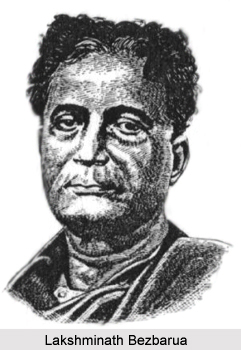 Assamese drama in the Jonaki era had more literary value than theatrical value. Much of the drama of this period was read rather than performed, and the following generation would put this drama on stage or at least borrow from their themes to do so. The first dramatic work of this period was Lakshminath Bezbarua`s `Litikai` (The Pages, or Lackeys), a farce serialized in 12 parts from the first issue of Jonaki. His other dramas were historical ones such as Chakradhwaj Singha and Joymati Kunwari, both taking up Ahom royalty as their primary characters. It was Benudhar Rajkhowa who was a more prolific playwright and whose plays contain strong satirical and often farcical characteristics. His plays, such as Kali Yuga (written in collaboration with another noteworthy litterateur, Durga Prasad Majindar Barua), Tint Ghaini (Three Wives), Asikshit Ghaini (The Uneducated Wife), and Sorar Sristi (The Thief`s Invention), depict various aspects of Assamese society of his day. With these plays, too, performance was not the primary concern.
Assamese drama in the Jonaki era had more literary value than theatrical value. Much of the drama of this period was read rather than performed, and the following generation would put this drama on stage or at least borrow from their themes to do so. The first dramatic work of this period was Lakshminath Bezbarua`s `Litikai` (The Pages, or Lackeys), a farce serialized in 12 parts from the first issue of Jonaki. His other dramas were historical ones such as Chakradhwaj Singha and Joymati Kunwari, both taking up Ahom royalty as their primary characters. It was Benudhar Rajkhowa who was a more prolific playwright and whose plays contain strong satirical and often farcical characteristics. His plays, such as Kali Yuga (written in collaboration with another noteworthy litterateur, Durga Prasad Majindar Barua), Tint Ghaini (Three Wives), Asikshit Ghaini (The Uneducated Wife), and Sorar Sristi (The Thief`s Invention), depict various aspects of Assamese society of his day. With these plays, too, performance was not the primary concern.
Though the drama in the Jonaki era was more read than performed, it is remarkable to note that, though early-modern Assamese literature, with a few exceptions, does not yield great dramas, Assamese society has always been a theatre-going one. Drama developed in Assam contemporaneously with English drama in the fifteenth century. Alongwith the English church performances, mysteries and morality plays, the neo-Vaishnavite movement established religious drama and, with it, a classical dance form, the Satriya (of the salras or monasteries). But Assamese drama did not develop in the manner of English drama, and the classical, devotional, and historical strains were still strong into the twentieth century.
Modern Assamese drama was established in the 1940s by Jyoti Prasad Agarwala and continues to flourish. But even today, perhaps fittingly, successful dramatists are defined by performances at large, rather than by publications. Masses of people flock to the touring theatre companies that move through the Assamese countryside and towns performing popular plays that are not to be found in published form. The establishment of All India Radio in 1948 saw the rise of another form of non-literary drama.













